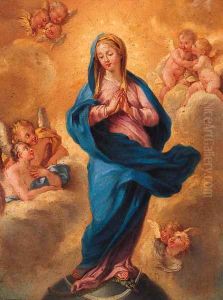Filipo Lauri Paintings
Filippo Lauri was an Italian painter born in 1623 in Rome, within the Papal States. He was a prominent figure in the Baroque period, known for his detailed and vibrant landscape and mythological paintings. Lauri’s artistic journey began under the guidance of his father, Balthasar Lauwers, a Flemish painter who had settled in Italy. However, it was under the tutelage of Angelo Caroselli that Lauri truly honed his skills, blending Flemish influences with the burgeoning Baroque style prevalent in Rome at the time.
Lauri became an esteemed member of the Accademia di San Luca, the prestigious academy of artists in Rome, in 1637, illustrating his early recognition and the esteem in which he was held by his contemporaries. His career flourished as he became known for his small-scale paintings, which were rich in detail and imbued with a lively, poetic quality. These works often featured pastoral scenes, religious and mythological subjects, populated with figures that demonstrated Lauri’s skill in capturing human emotion and the nuanced play of light and shadow.
Throughout his life, Lauri collaborated with several notable artists of his time, including his brother-in-law, Filippo Gagliardi, and Giovanni Francesco Grimaldi. A significant aspect of his work involved creating the figures for landscapes painted by other artists, most notably the landscapes of his brother-in-law, Gagliardi, and those of Gaspar Dughet, who was Poussin’s brother-in-law. These collaborations were a testament to Lauri’s versatility and his ability to enhance the narrative and aesthetic quality of the landscapes with his detailed and dynamic figures.
Lauri’s influence extended beyond his lifetime through his students, among whom was his son, Filippo Lauri the Younger, ensuring the continuation of his artistic legacy. He died in 1694 in Rome, leaving behind a body of work that remains celebrated for its contribution to the Baroque movement and its influence on the development of landscape and mythological painting in Europe. Lauri’s artistry is remembered for its vibrancy, attention to detail, and the seamless integration of human figures with the natural world, marking him as a key figure in the transition between the Renaissance and Baroque periods.
